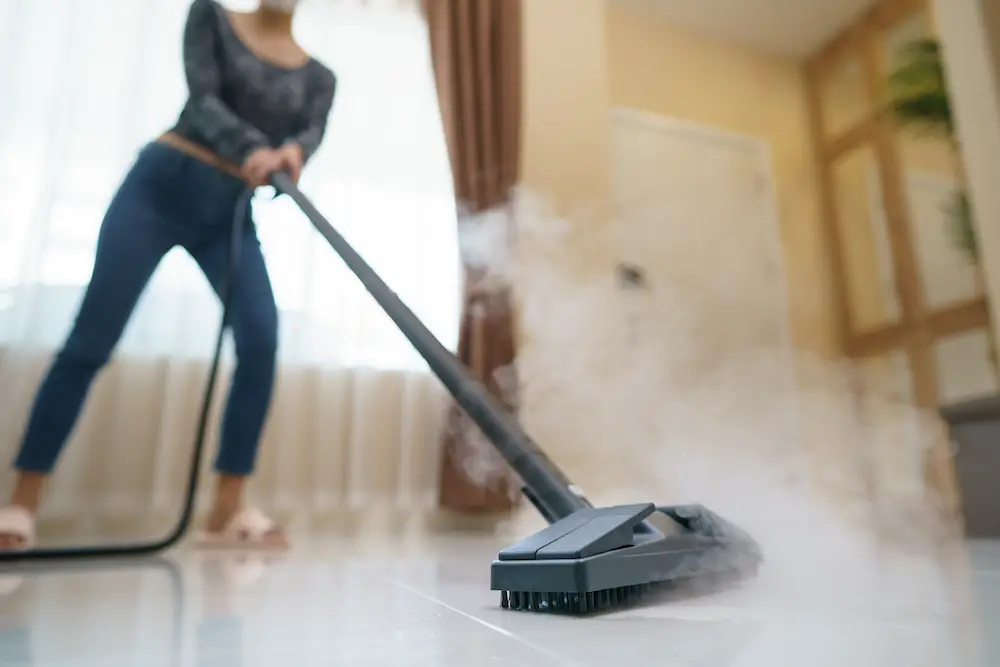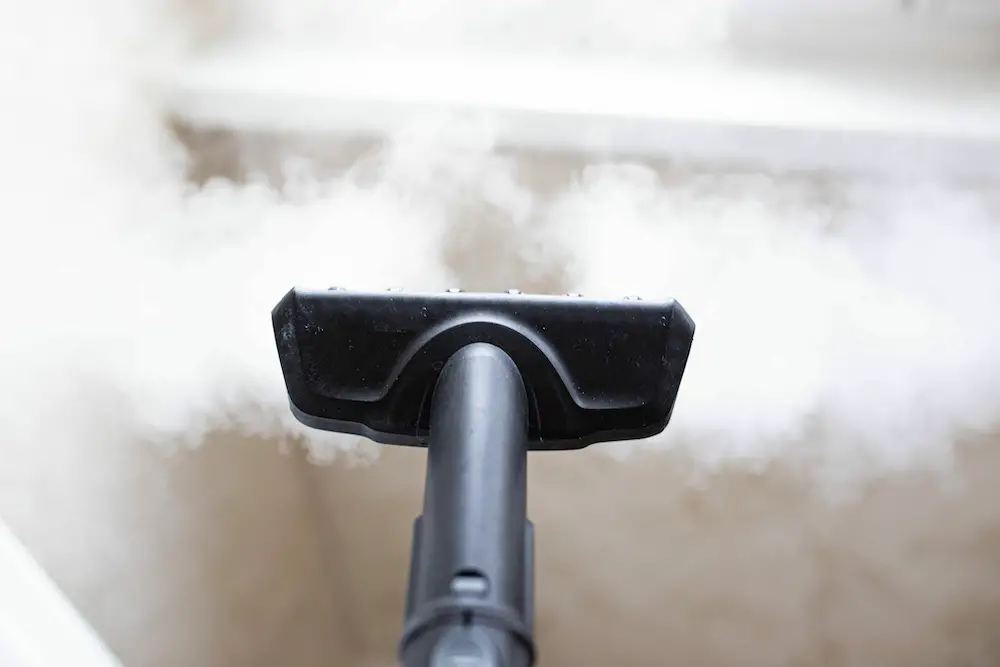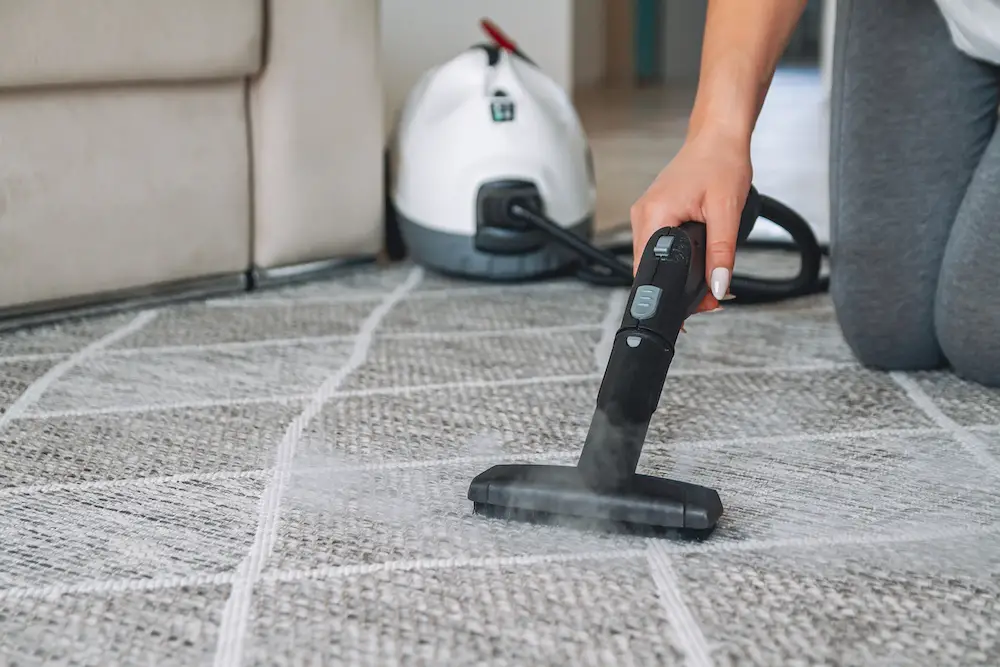How does steam cleaning work? If you are asking the same question, you are not alone.
More and more people are discovering the advantages of using a steam cleaner and wonder what makes it tick.
The growing interest goes beyond simple curiosity too. Knowing the process more intimately allows you to optimize the machine’s capability.
With this information, you would have a good idea of when and where to use the steam cleaner.
You would also be able to operate it properly, maximizing not only its performance but also its length of service.
To help you understand your cleaning tool more deeply, here are the answers to some of the burning questions surrounding steam cleaners.
How Does Steam Cleaning Work?
Steam cleaners are aptly named because they use hot, vaporized water to disinfect different surfaces.
However, things are not as simple as they sound.
There’s a lot more to the process than simply boiling water and pointing the nozzle.
Let’s lay the groundwork by looking at the main components.
Every steam cleaner has a water tank and a boiler.
Some models have a compartment for soap, although the steam alone should be enough to get the job done.
Different brands also have different attachments, allowing you to clean various surfaces at home.
Before turning on the steam cleaner, you need to fill the water tank first.
Different models have different tank sizes, so make sure that you do not put in too much to avoid overflow.
Next, plug the machine into a wall socket to start the boiling process.
Some models have light indicators that tell you if the right temperature has been reached.
Once the water evaporates, the steam cleaner uses pressure to force the steam out through the nozzle when activated.
This feature is important, as the combination of heat and pressure is key to the cleaning process.
When the machine releases the steam to a surface, the vapor molecules force out the dirt, grease, and grime.
It also kills bacteria, viruses, bugs, fleas, flea eggs, and other microorganisms.
Basically, what you will get is a surface that does not only look clean but is also sanitized.
What’s more, there is also little to no odor left.
Another thing you will like about using steam cleaners is that the vapor dries quickly.
In other words, you will leave very little chance for mold or mildew to grow again on the surface after cleaning.
Some models have a built-in steam vacuum that takes away the dirt and grime as you run the steamer.
Industrial brands also have separate non-pressurized tanks that let you refill the machine while running. This would mean continuous cleaning. Smaller models have to turn off to refill.
What Surfaces Do Steam Cleaners Work On?
Most steam cleaners are designed for floors and carpets. Nevertheless, you can also use them to clean many other surfaces.
This is why many steam cleaner models come with an assortment of accessories.
There are attachments you can attach to the end of the hose to clean couches, appliances, countertops, and tiles.
Others will allow you to clean curtains, clothes, and other similar materials.
With a steam cleaner, you can make quick work of a mucky oven or a grimy tile grout. It can also get rid of bed bugs.
Essentially, you can clean the entire house using this cleaning tool. Even better, it is just as effective outside the house.
Steam cleaners will work on pet cages, patios, garden furniture, and litter boxes. You can even use it to kill weeds and algae in swimming pools.
Aside from homeowners, another sector that will benefit from using a steam cleaner is the automotive industry.
The steam cleaner proves very effective in cleaning vinyl, leather, and other fabric types inside the car.
You can use it to disinfect dashboards, vents, moldings, chrome, and bumpers.
The steam cleaner is also a must-have for industrial kitchens. It can disinfect stainless-steel appliances and surfaces without relying on harsh cleaning agents.
So, if you run a restaurant or cafeteria, you should invest in an industrial-grade steam cleaner.
What Surfaces Should Not Be Steam Cleaned?
As you can see, the list of surfaces you can clean using a steam cleaner is very long.
However, it is also important to note the things you should not disinfect with this cleaning tool.
Steer clear of polished, unsealed, waxed, or freshly painted surfaces. Also, do not use the steamer on painted walls as excessive heat can strip the paint. Wall-paper is also a no-no unless you want to remove it!
Many interior paints are water-soluble and would start running under the heat and moisture of the steam.
Wood, paper, plywood, laminate floors, and cardboard could also warp if exposed to high-temperature steam for long periods.
In most cases, the moisture absorbed by these materials could encourage mold growth.
Check the fabric codes on your upholstery. Linen, suede, and some other fabrics will tell you how best to treat them on the tag. Test a hidden area first.
Finally, make sure you do not use the steam cleaner on cold windows.
The rapid and significant rise in temperature can cause the glass to crack, leaving you with an exposed window during winter.

Why Is Steam Cleaning Better?
By now, you probably have a good idea of the benefits you can enjoy from using a steam cleaner.
Even so, it is important to take a deeper look at the many reasons why steam cleaning is better.
First of all, using steam to clean surfaces eliminates the need for harsh chemicals and cleaning agents.
If you have kids and pets at home, you won’t have to worry about leaving behind irritants that could affect their health.
It would also give you peace of mind when preparing food on your kitchen countertop.
In other words, the steam cleaner is tough on dirt but gentle on your family.
Plus, it reduces the chemicals that go down the drain, which means that it is environment-friendly.
Another reason you should consider investing in a steam cleaner is that it offers a different level of cleaning.
The pressure and temperature of the steam works like a powerful 1-2 punch, eliminating both visible stains and invisible contaminants.
It is true even for hard-to-reach places, corners, and crevices.
If you choose the right brand or model, you could take on virtually any cleaning task inside and outside your home.
This brings us to the next advantage of steam cleaning—you won’t have to stock different cleaning agents under the sink.
Once you invest in a steam cleaner, you do not have to waste money on consumable cleaning materials.
While the steam cleaner is more expensive up front, in the long run, you still win in terms of cost.
How To Use a Steam Cleaner
Like any other appliance, the safety and effectiveness of the steam cleaner depend on proper use.
The good thing is that it is very easy to operate. Nevertheless, you can do a few things to make things even easier.
As mentioned, start by filling the water tank first before you turn the machine on.
Some models require distilled water, while others accept tap water. Fill it to maximum capacity to ensure you get the optimum cleaning time.
Next, attach the appropriate accessory, depending on the task at hand.
You can then plug the machine into the wall socket and wait for it to heat up.
While waiting, or even before plugging the machine in, you can prepare the area you will clean.
If you’d be cleaning your carpet, vacuum it before running the steamer over it.
For mattresses, remove everything first, including the cover. You could also sprinkle baking soda over the surface to help with the odor.
If you use baking soda, make sure you vacuum it up before using the steam cleaner.
When it comes to couches, the steam cleaning process is more or less the same.
Remove the covers and cushions first before you proceed.
Additionally, check the age or quality of your upholstery. If the fabric is old or thin, use a moderate setting.
You can also use the steam cleaner to clean curtains, but you would have to do things a bit differently.
For instance, aside from vacuuming the dust and debris, you should also remove the lint using a brush.
Lint sticks to curtains, and there is a good chance the vacuum would not be able to remove it.
After using the brush, you can start using the steam cleaner.
Steam Cleaner Buying Guide
Different households have different needs, so choosing the right steam cleaner is crucial.
That said, given the countless brands and models available today, this decision is not as easy as it sounds.
The good thing is that there are ways to narrow down your options. One is by looking at the capacity of the water tank.
If you have a large property and plan to sanitize it regularly, invest in a canister steamer.
This type of steam cleaner can provide 45 minutes of cleaning time or more.
For smaller cleaning tasks, the handheld model is a better option. It is capable of 10 minutes of continuous steam.
Another feature you should look at is the time it takes to heat up.
Larger steam cleaners generally take several minutes to vaporize the water, while smaller models can do it in one minute or less.
That said, there are some variations from brand to brand, and you can factor this into your decision-making process.
Aside from the capacity and heat-up time, you should also consider the efficiency of the steam cleaner.
One indication of this is the amount of time you need to hold the nozzle in place to clean a surface effectively.
Some models need only a few seconds, while others could go as long as a minute.
Finally, look at the price tag of the steam cleaner and weigh this against the performance that it can offer.

Understanding the Power of Steam
To get the most out of your steam cleaner, you need to know how steam cleaning works first.
However, it is only one of the many things you need to figure out.
It would be best if you know what surfaces you can use a steam cleaner on and what to look for when shopping around for one.
Armed with all this information, you can fully appreciate and experience the power of this awesome cleaning tool.

